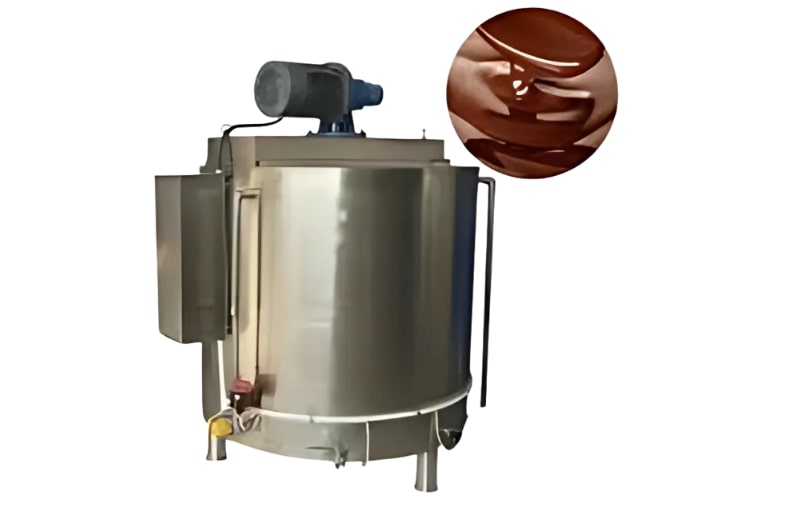-
Send us a mail [email protected]
-
Call us anytime +91-9999884400

These specialized tanks are engineered to store, melt, mix, and hold chocolate at precise temperatures, ensuring it remains in optimal condition until it moves to the next stage of production. Whether you’re running a large-scale confectionery plant or a chocolate molding facility, having a high-quality stainless steel holding tank can make a significant difference in both efficiency and product consistency.
Stainless steel is the preferred material for chocolate holding tanks for several reasons. Firstly, it offers superior corrosion resistance, which is vital in a food-grade environment where hygiene is paramount. Stainless steel does not react with chocolate or cleaning agents, which helps in preserving the flavor and safety of the product. Moreover, its thermal conductivity ensures even heat distribution, which is crucial for maintaining the desired viscosity and texture of molten chocolate.
Another key reason manufacturers opt for stainless steel is its durability and low maintenance. Industrial environments are demanding, and tanks must withstand not only high volumes of chocolate but also continuous use and rigorous cleaning cycles. Stainless steel tanks meet these requirements while offering a long service life, reducing the need for frequent replacements or costly repairs.
When looking for the best stainless steel chocolate holding tanks for industrial use, there are several essential features to consider. The first is temperature control. Chocolate is extremely sensitive to temperature changes. A fluctuation of even a few degrees can result in undesirable changes in texture or crystallization. Modern holding tanks come with digital thermostatic controls and double-jacketed walls that allow for precise temperature regulation using water or oil heating systems.
Another critical feature is agitation or mixing functionality. Chocolate must be stirred gently but consistently to maintain its smoothness and prevent the separation of cocoa butter. Top-tier tanks feature variable-speed agitators that ensure consistent flow and maintain uniform temperature throughout the mixture.
Capacity is also a factor. Industrial operations typically require large-capacity tanks, ranging from several hundred to thousands of liters. Leading manufacturers offer customizable tank sizes to suit various levels of production demand. Additionally, the best tanks are designed for easy integration into existing chocolate production lines, complete with ports for automatic filling, level indicators, and CIP (clean-in-place) systems.
One of the most significant advantages of using stainless steel chocolate holding tanks is the improvement in product consistency. With precise temperature and mixing control, manufacturers can produce batches of chocolate that are uniform in flavor, texture, and appearance. This consistency is especially important for brands focused on premium quality.
Operational efficiency is another major benefit. A stainless steel tank with automation-ready features minimizes manual labor, reduces human error, and accelerates production. This leads to higher throughput, allowing factories to meet growing market demands without sacrificing quality.
From a hygiene perspective, stainless steel is non-porous and easy to clean, which minimizes the risk of contamination. Most industrial-grade tanks meet strict food safety standards and are designed for fast, thorough sanitation, reducing downtime between production cycles.
Selecting the best stainless steel chocolate holding tank for your industrial operation involves evaluating your specific needs. Consider the type of chocolate you’re producing—dark, milk, or white—as each may require slightly different temperature settings. You should also account for your daily production volume, space constraints, and integration with other machinery like tempering units, pumps, and enrobing machines.
Reputable manufacturers offer consultation services to help you choose or design a tank that matches your exact specifications. Customizable features such as tank insulation, level sensors, discharge valves, and control interfaces make it easier to align the tank with your broader production goals.
These tanks are essential across many sectors of the food industry. Confectionery manufacturers use them to store tempered chocolate before molding or coating. Bakeries utilize them for ganache and fillings, while ice cream and dessert producers rely on them to maintain liquid chocolate for swirls and layers. Large-scale chocolatiers and contract manufacturers benefit from their reliability and scalability, particularly during peak production seasons.
In conclusion, investing in the best stainless steel chocolate holding tanks for industrial use is crucial for maintaining product quality, improving production efficiency, and meeting food safety regulations. With advanced features such as precise temperature control, agitation, and integration compatibility, these tanks have become indispensable assets in modern chocolate production facilities. Whether you’re scaling up operations or upgrading your current equipment, choosing a high-quality stainless steel tank is a smart, long-term investment for any chocolate manufacturing business.
Ans. A stainless steel chocolate holding tank is used to store, maintain, and gently mix melted chocolate at a consistent temperature, ensuring quality and flow in large-scale manufacturing environments.
Ans. Stainless steel is corrosion-resistant, easy to clean, and food-safe. It maintains hygiene standards while offering excellent durability and temperature control, making it ideal for chocolate processing.
Ans. A double-jacketed tank allows precise thermal regulation using heated water or oil, helping maintain the optimal temperature of chocolate without scorching or crystallization.
Ans. Yes, most industrial stainless steel chocolate holding tanks are designed for full integration with tempering machines, enrobing systems, and automated dosing lines for streamlined operations.
Ans. Key features include temperature control systems, agitation or mixing capabilities, food-grade stainless steel construction, easy cleaning access (CIP systems), and compatibility with production equipment.
